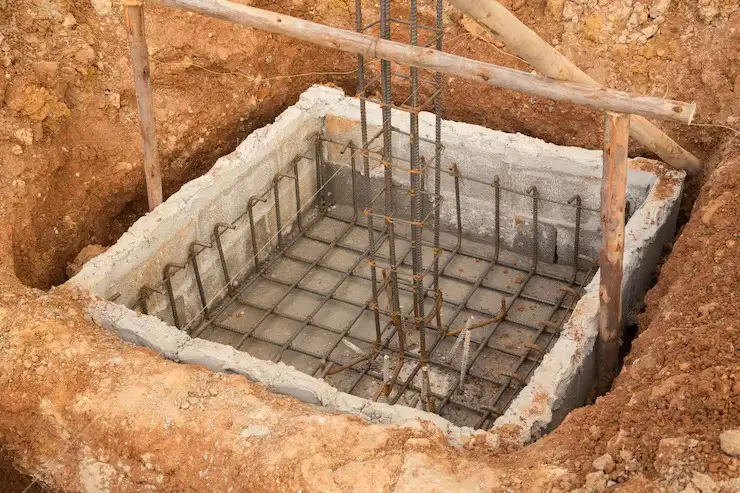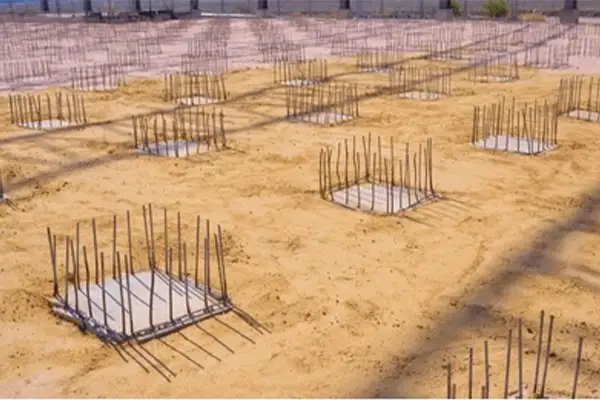In a home construction, the foundation is the bedrock, supporting the entire structure. The foundation is the lowest part of the building that is in direct contact with the soil, which helps to transfer load from the structure to the ground. First, you should know about all the basic details of a solid foundation and its types to complete your home construction process without any issues.
In this blog, Brick&Bolt gives you detailed information about the foundation for homes, types of foundations, and the pros and cons of the different types of foundations.
So, let’s start the journey!
What is a Foundation and Its Importance?
In construction terms, a foundation is a structure that supports the building and transfers its load to the ground. It serves as the anchor that ensures stability, preventing settlement or collapse. There are two main types of foundations: shallow and deep foundations. You can choose your suitable type based on factors such as soil conditions, climate, and the overall design of the building.
In India, the soil varies a lot, ranging from clayey soil to sandy ground. You should also consider factors such as earthquake-prone areas to decide which type of foundation will suit your location. It’s important to note that a thorough seismic analysis (a subset of structural analysis and is the calculation of the response of a building or nonbuilding structure to earthquakes and design should be conducted by qualified structural engineers to ensure the chosen foundation type meets the specific requirements of the site and local building codes in earthquake-prone areas. A well-planned and adequately strong foundation is a basic necessity in India, ensuring homes that last a long time and are safe.
Let’s dive into the different types of foundations that are commonly used for house construction in India.
Different Types of Foundations Used in Construction in India
There are mainly two types of foundations used in India for house construction.
- Shallow Foundation
- Deep Foundation
1. Shallow Foundation:
A shallow foundation is a type of foundation that transfers the loads of a building to the earth very near to the surface rather than to deeper layers of soil or rock. These foundations are usually used for small, simpler structures such as houses and low-rise structures.. It spreads the load of a building over a larger area close to the surface, providing support without the need for extensive excavation.
Shallow foundations are constructed where the soil can adequately support the structure without deep excavation. Their suitability depends on soil type, seismic activity, and project requirements. Structural reports and technical analyses are also vital in determining India’s most appropriate foundation type for house construction.
Types of Shallow Foundations:
There are five types of shallow foundations, and they include
- Isolated / Individual Footings
- Combined Footings
- Raft or Mat Foundations
- Strip Foundations
Let’s dive deep into the types of shallow foundations:
Isolated /Individual Footings:
Individual Isolated footing is the most common type of shallow foundation used for building construction. It is also known as a pad foundation, and this kind of foundation is designed to hold up a single column.
Combined Footings:
A combined footing is a foundation that distributes the weight over a larger surface area, thereby supporting two or more columns or walls. When walls or columns are near to one another, and the soil has the potential to be stronger, people use it.
Raft or Mat Foundations:
A raft or mat foundation serves similar to a large, level slab of ground beneath a whole building. It distributes the weight of the construction over the ground and helps in supporting it. In order to ensure that the building remains solid and that the weight is distributed uniformly, raft foundations are a great choice.
Strip Foundations:
The structure that supports a building is made up of closely spaced rows of columns and a long, continuous strip of concrete called a strip foundation, also known as a strip footing. The entire ground is supported by the weight of the columns and walls.
Slab-on-Grade Foundations:
When concrete is poured directly into the site to form a solid slab that serves as the foundation for the structure constructed on it, this type of foundation is known as a slab-on-grade foundation. The phrase “on grade” describes how this kind of foundation can be built directly on the site’s natural grade without requiring expensive excavation work or creating a lower level or basement. It’s a common foundation choice for many types of buildings, particularly in regions where freezing occurs since the ground doesn’t freeze very far below the surface.
Advantages of Shallow Foundation in Indian Soil and Climate:
- Cost-Effective: Shallow foundations are generally more budget-friendly than deep foundations, requiring less excavation and materials.
- Speedy Construction: Shallow foundations can be built quickly, making them suitable for projects with tight deadlines.
- Accessibility: These foundations are easily accessible for inspections, maintenance, and repairs due to their proximity to the surface.
- Suitability for Light Structures: Shallow foundations are well-suited for supporting light to moderate-weight structures like residential buildings.
Disadvantages of Shallow Foundations in Indian Soil and Climate
- Limited Load-Bearing Capacity: Shallow foundations may not be appropriate for heavy or tall structures, as the soil near the surface might not bear sufficient load.
- Sensitivity to Soil Changes: Shallow foundations can be sensitive to soil condition changes, like swelling or settling, affecting their stability.
- Not Ideal for Weak Soils: In weak or unstable soils, shallow foundations may need more support, leading to structural issues.
Suitability of Shallow Foundation for Indian Soil and Climate:
In India, shallow foundations, including spread footings and slab-on-grade foundations, are well-suited for various soil conditions. They can be effectively designed for cohesive soils like clay and granular soils like sand. The adaptability to diverse soil types makes them versatile for construction projects in regions with varying geological profiles.
Shallow foundations are commonly used in densely populated urban areas with limited space, and construction must often occur near existing structures. Cities like Mumbai, Chennai, and Kolkata frequently employ shallow foundations due to their practicality and efficiency in constrained spaces.
Shallow foundations are generally more cost-effective compared to deep foundations. The reduced excavation depth and simplicity of construction contribute to lower overall project costs, making them an attractive option for many construction projects.

Deep Foundations
Deep foundations are the type of foundations that transmit the load of the structure further down the earth in comparison to shallow foundations. Typically, the depth-to-width ratio of this foundation exceeds 4 to 5. In practical terms, if the width of the foundation is W, the depth would be at least 4 to 5 times that value, creating a foundation that is deeper in the ground compared to its horizontal dimensions. This design consideration often uses deep foundations to enhance their load-bearing capacity and overall performance. These foundations are employed when shallow foundations are impractical due to inadequate soil strength or when the construction project requires support at considerable depths.
Types of Deep Foundations:
There are five types of deep foundations generally used in home construction. They include
- Pile Foundations
- Well Foundations
- Basement Foundation
- Buoyancy Raft
- Shaft Foundations
Pile Foundations:
A pile foundation is a type of deep foundation that uses vertical columns or piles that are drilled, cast, or driven into the ground. These piles transfer a structure’s weight into the foundation or deeper, more stable soil layers.
Caisson or Well Foundations:
Large-scale structures like bridges and piers are supported by foundational parts called caisson foundations. Most of the time, they are cylindrical. In order to offer stability and support in trying circumstances, these foundations are submerged underwater during construction.
Basement Foundation:
A basement foundation supports a house or other building site that is located one or more layers below ground level. Except for basement foundations, all foundation types are largely covered. One special feature of a basement foundation is the capacity to construct a “finished” basement, which may be used as a regular room or multipurpose area beneath the main building.
Buoyancy Raft:
The buoyancy raft foundation is a type of deep foundation design that takes the theory of buoyancy effects into consideration. As a result, the resulting net weight on the ground is decreased, reducing the total and differential settlements of the foundation.
Building buoyancy rafts involves excavation to a depth where a hollow foundation structure is formed, and the weight of the removed soil is either equal to or slightly less than the combined weight of the substructure and superstructure.
Shaft Foundations:
Shaft foundations, also referred to as drilled piers, are a common and adaptable architectural element found all over the world. A drilled shaft foundation is constructed, in the most basic case, by digging a cylindrical hole, adding a reinforcement cage, and then filling the opening with concrete. Deeper than 76.0 m and shaft diameters up to 6.0 m are possible when drilling and other supporting arrangements are available at the site.
Advantages of Deep Foundations in Indian Soil and Climate:
- High Load-Bearing Capacity: Deep foundations support substantial loads, making them ideal for large structures.
- Enhanced Stability: It is particularly effective in weak or variable soils, providing superior stability.
- Settlement Control: Minimises the risk of uneven settling, ensuring consistent support across the structure.
- Versatility: They are well-adapted to various soil conditions, making them suitable for diverse environmental contexts.
Disadvantages of Deep Foundations in Indian Soil and Climate:
- Higher Cost: Due to increased material and labour requirements, deep foundations are more expensive than shallow foundations.
- Complex Construction: The construction process for deep foundations can be intricate and time-consuming.
- Dependent on Depth: The effectiveness of deep foundations relies on reaching competent soils or bedrock at a significant depth.
Suitability of Deep Foundations for House Construction in India
Deep foundations are often used in urban areas where the soil conditions are challenging or buildings require additional support to resist heavy loads or adverse geological conditions.
Deep foundations are excellently suited for areas with seismic activity, providing stability during earthquakes. It is also effective in coastal areas where high water tables or soil erosion might impact stability.

Conclusion
the foundation for homes in India must be designed and constructed carefully considering the local geological and climatic factors. A holistic approach that combines traditional wisdom with modern innovations can contribute to creating resilient, sustainable, and safe housing for the diverse population of India. Shallow foundations are preferable for lightweight structures on stable soils. Deep foundations are used for larger projects or in cases where the soil is not strong enough since they ensure adaptability and suitability across India’s diverse terrain.

